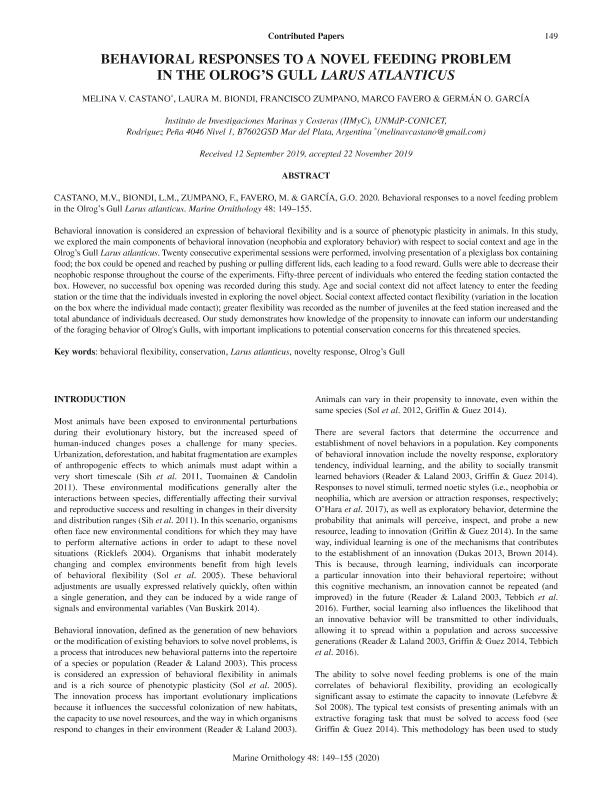Artículo
Behavioral responses to a novel feeding problem in the Olrog's Gull Larus atlanticus
Fecha de publicación:
10/2020
Editorial:
Pacific Seabird Group
Revista:
Marine Ornithology
ISSN:
1018-3337
e-ISSN:
2074-1235
Idioma:
Inglés
Tipo de recurso:
Artículo publicado
Clasificación temática:
Resumen
Behavioral innovation is considered an expression of behavioral flexibility and a source of phenotypic plasticity in animals. Here, we explored the main components of behavioral innovation (neophobia and exploratory behavior) with respect to social context and age in Olrog's Gulls Larus atlanticus. Twenty consecutive experimental sessions were performed, involving presentation of a plexiglass box containing food; the box could be opened and reached by pushing or pulling different lids, each leading to a food reward. Gulls were able to decrease their neophobic response throughout the course of the experiments. Fifty-three percent of individuals who entered the feeding station contacted the box. However, no successful box opening was recorded during this study. Age and social context did not affect latency to enter the feeding station or the time that the individuals invested in exploring the novel object. Social context affected contact flexibility (variation in the location on the box itself where the individual made contact); greater flexibility was recorded as the number of juveniles at the feed station increased and the total abundance of individuals decreased. Our study demonstrates how the propensity to innovate may play a role in understanding foraging behavior and its relevance to potential conservation concerns for this threatened species.
Archivos asociados
Licencia
Identificadores
Colecciones
Articulos(IIMYC)
Articulos de INSTITUTO DE INVESTIGACIONES MARINAS Y COSTERAS
Articulos de INSTITUTO DE INVESTIGACIONES MARINAS Y COSTERAS
Citación
Castano, Melina; Biondi, Laura Marina; Zumpano, Francisco; Favero, Marco; García, Germán Oscar; Behavioral responses to a novel feeding problem in the Olrog's Gull Larus atlanticus; Pacific Seabird Group; Marine Ornithology; 48; 2; 10-2020; 149-155
Compartir




